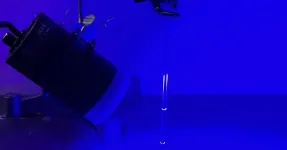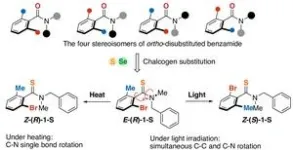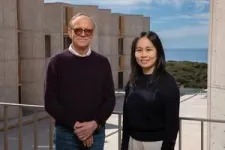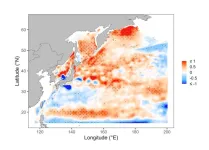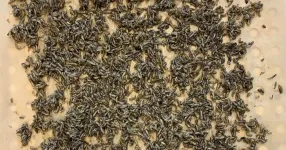(Press-News.org) Molecules that are induced by light to rotate bulky groups around central bonds could be developed into photo-activated bioactive systems, molecular switches, and more.
Researchers at Hokkaido University, led by Assistant Professor Akira Katsuyama and Professor Satoshi Ichikawa at the Faculty of Pharmaceutical Sciences, have extended the toolkit of synthetic chemistry by making a new category of molecules that can be induced to undergo an internal rotation on interaction with light. Similar processes are believed to be important in some natural biological systems. Synthetic versions might be exploited to perform photochemical switching functions in molecular computing and sensing technologies, or in bioactive molecules including drugs. They report their findings in Nature Chemistry.
“Achieving a system like ours has been a significant challenge in photochemistry,” says Katsuyama. “The work makes an important contribution to an emerging field in molecular manipulation.”
Insights into the possibilities for light to significantly alter molecular conformations have come from examining some natural proteins. These include the rhodopsin molecules in the retina of the eye, which play a crucial role in converting light into the electrical signals that create our sense of vision in the brain. Details are emerging of how the absorption of light energy can induce a twisting rearrangement of part of the rhodopsin molecule, required for it to perform its biological function.
“Mimicking this in synthetic systems might create molecular-level switches with a variety of potential applications,” Katsuyama explains.
A key innovation by the Hokkaido team was to achieve photo-induced (i.e., light-driven) rotation of molecular groups around a series of chemical bonds that incorporate a nitrogen atom together with other bonded carbon atoms.
The rotational properties were enabled by adding molecular components that contained an atom from the ‘chalcogen’ group of elements in the periodic table, specifically sulfur or selenium, to a simple organic molecule: an amide compound. This brought a new level of control and versatility to synthetic photo-induced rotational systems.
Some of the chemical groups that rotate around the central bonds were relatively large, based on rings of six bonded carbon atoms. This facilitated the large-scale molecular changes that might be required for practical use in molecular switching systems.
In addition to demonstrating the photo-induced changes, the team also performed theoretical calculations that gave insights into the likely mechanisms by which the rearrangements proceeded. The team also explored the effects of temperature on the transformations. The combination of theoretical and experimental work should help guide future research towards exploring and controlling modifications to the systems already achieved.
"Our next research priority is focused on the potential of our methods for making new bioactive molecules activated by light. These could be applied in biological research or possibly developed as drugs,” Ichikawa concludes.
Using light to activate the conformational changes allows control over where and when the changes occur. This could be vital for precisely targeted applications in biological systems, including eventual therapeutic possibilities.
END
Light stimulates a new twist for synthetic chemistry
2024-02-28
ELSE PRESS RELEASES FROM THIS DATE:
More than just neurons: A new model for studying human brain inflammation
2024-02-28
LA JOLLA (February 28, 2024)—The brain is typically depicted as a complex web of neurons sending and receiving messages. But neurons only make up half of the human brain. The other half—roughly 85 billion cells—are non-neuronal cells called glia. The most common type of glial cells are astrocytes, which are important for supporting neuronal health and activity. Despite this, most existing laboratory models of the human brain fail to include astrocytes at sufficient levels or at all, which limits the models’ utility for studying ...
Urgent need to develop best practices to advance use of AI in cardiovascular care
2024-02-28
Statement Highlights:
The American Heart Association encourages research and development of artificial intelligence (AI) and other related tools and services that may support and enable more precise approaches to cardiovascular and stroke research, prevention and care.
Academia, industry and governments worldwide are pouring resources into developing AI-based tools to transform how and when health care is delivered.
While promising research is beginning to emerge in many areas of cardiovascular medicine, AI-based tools, algorithms and systems of care have not yet been proven to improve care enough to justify widespread use.
AI and machine learning digital tools currently exist that ...
Smoking cannabis associated with increased risk of heart attack, stroke
2024-02-28
Smoking cannabis associated with increased risk of heart attack, stroke
NIH-funded observational study shows risk grows sharply with more frequent use
Frequent cannabis smoking may significantly increase a person’s risk for heart attack and stroke, according to an observational study supported by the National Institutes of Health. The study, published in the Journal of the American Heart Association, uses data from nearly 435,000 American adults, and is among the largest ever to explore the relationship ...
NYUAD researchers highlight a potential flaw in operating room ventilation that increases risk of infection by COVID-19
2024-02-28
● Simple modifications to ventilation systems improve airflow, making operations safer for both patients and surgical teams
● This research was conducted in close collaboration with a team of surgeons from Cleveland Clinic Abu Dhabi (CCAD)
Abu Dhabi, UAE, February 28, 2024: NYU Abu Dhabi (NYUAD) engineers studying ventilation systems in surgical operating theaters have found that traditional ventilation systems may inadvertently facilitate the circulation of aerosolized pathogen-carrying particles. This, as a result, puts surgical teams at a higher risk of infection by COVID-19 and other airborne diseases.
Using basic engineering tools, including ...
Climate change shrinking fish
2024-02-28
Fish weight in the western North Pacific Ocean dipped in the 2010s due to warmer water limiting food supplies, according to a new study at the University of Tokyo. Researchers analyzed the individual weight and overall biomass of 13 species of fish. In the 1980s and 2010s, the fish were lighter. They attributed the first period of weight loss to greater numbers of Japanese sardine, which increased competition with other species for food. During the 2010s, while the number of Japanese sardine and chub mackerel moderately increased, the effect of climate change warming the ocean appears to have resulted ...
Yeast and kelp flies can replace fishmeal in feed
2024-02-28
Kelp flies and marine yeast cultivated on by-products from the seafood industry can be used in feed for farmed salmon. Replacing fishmeal and soybeans can create more sustainable and circular food production, according to a thesis from the University of Gothenburg.
Food from aquaculture, such as farmed fish, is the food industry’s fastest growing sector. One key reason is that this is a nutritious and protein-rich food that is generally more sustainably produced than protein from land animals.
However, fish farming also has challenges. One is obtaining sufficient amounts of sustainable high-quality feed. Currently, fish feed accounts for about ...
Meltwater in the North Atlantic can lead to European summer heatwaves, study finds
2024-02-28
Scientists from the National Oceanography Centre (NOC) have discovered that increased meltwater in the North Atlantic can trigger a chain of events leading to hotter and drier European summers.
The paper, which will be published in the European Geosciences Union’s open access journal Weather and Climate Dynamics, suggests that European summer weather is predictable months to years in advance, due to higher levels of freshwater in the North Atlantic.
Discussing the implications, lead author Marilena Oltmanns, Research Scientist at the National Oceanography Centre, said: “While the UK and northern Europe experienced unusually cool and wet weather in Summer 2023, Greenland experienced ...
A threat to what is ours: How Japanese people react to perceived territorial infringements
2024-02-28
Osaka, Japan – Throughout the world, it is common for threats to national sovereignty or territorial integrity to stir up strong emotions among the public. Now, researchers from Japan have found that the strength of the reaction to such threats can break down along political lines in interesting ways.
In a study published in Peace and Conflict: Journal of Peace Psychology, researchers from Osaka University have revealed that the Japanese public is highly sensitive to what are known as “collective ownership ...
Experiment captures why pottery forms are culturally distinct
2024-02-28
Potters of different cultural backgrounds learn new types differently, producing cultural differences even in the absence of differential cultural evolution. The Kobe University-led research has implications for how we evaluate the difference of archaeological artifacts across cultures.
Cultural artifacts differ between cultures but are relatively stable within cultures. This makes pottery, and in particular its form, an important archaeological indicator to determine the presence of different cultural groups in specific locations and how they influenced each other over time. But where do such culturally stable variations arise from? The typical explanation for this is through “selective ...
A liking for licking
2024-02-28
HONG KONG (28 Feb 2024) — Unique insights into the social lives of cattle revealed in a new study by scientists at City University of Hong Kong (CityUHK) can enhance our understanding of animal behaviour and welfare. The study suggests that sex and social status influence social grooming (where one animal licks another, also known as allogrooming) among free-ranging feral cattle in Hong Kong.
The CityUHK researchers found that feral cattle performed preferential grooming of certain individuals and, in particular, that more dominant females received more grooming. This asymmetrical distribution of licking also applied to whom male cattle decided to ...
